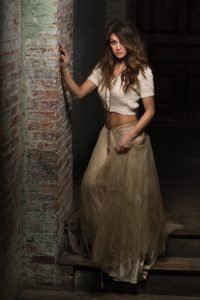+ By Desiree Smith-Daughety + Photos by Gregg Patrick Boersma
“Our job is not to figure out the ‘how.’ The ‘how’ will show up out of the commitment and belief in the ‘what.’”
‒ Jack Canfield, Author and Motivational Speaker
Gregg Patrick Boersma’s mesmerizing images are built on a foundation made from an inherent wisdom often learned in the teachings of Jack Canfield. That wisdom is that wherever you put your attention, that is what you will attract into your life. As such, Boersma has moved the needle on his craft mastery, from nice pictures to arresting photographs that inexorably draw you in and make you linger, trying to pinpoint their magnetism.
The reason for his shift could be due to his merging of two essential elements. “What I’m creating I believe is art, but it takes some elements of science to get there,” he says.

Brooke Roush in Graffiti Warehouse, Baltimore, MD. Make-up and styling by Nicole Palermo of Happily Ever After, LLC.
Boersma describes himself as someone who has always pursued a series of obsessive interests, including backpacking and cycling. Photography, however, has consistently engaged him.
For years, Boersma remained mired in the same spot where many photography enthusiasts live: able to wield a camera but not entirely sure how to maximize its gadgetry. Around age nine, he picked up his first camera, a 35mm, at a yard sale, and then progressed to building a dark room in his parents’ basement.
The opposite of dark is light, and that’s where, just a half-decade ago. Boersma began focusing his attention. He took advantage of a two-week Christmas holiday break to zoom in on one particular area, how to use his flash. “In fact, I hated using it, didn’t know how to control or operate it—just set it to auto,” he says. He wanted to master using the various settings, along with how to harness the intangible power of light. Something about its subtle but impactful hold over optics snagged him. “I became obsessed with controlling the lighting,” he explains. As part of his self-education, Boersma set out to become proficient by practicing on the easiest subject at hand, his dog Griffin, and analyzing and deconstructing magazine photographs that he loved.
Boersma played with off-camera flash—“and it’s gotten bigger and bigger,” he says. He now uses portable studio strobes, which he portages to locations everywhere, whether a grassy field, body of water, or parking garage. The electricity that sparks Boersma is the conundrum that lighting presents. He puzzles how he can light a subject to make it as dramatic or as beautiful as he can. “It’s sort of a game for me—that’s the part I love, working with the lighting. Once you get lighting right, the camera work is relatively easy.”
While most photographs receive some retouching, the majority of Boersma’s are done onsite, using appropriate lighting. “If you get the lighting right, you don’t need a lot of Photoshop,” he says.
He shifted from photographing Griffin to snapping other people’s dogs. It naturally followed that people wanted to be in the images, alongside their beloved canines. This presented a dilemma for Boersma, whose experience was firmly planted in the realm of every subject except people. Once again, he made another pointed decision and set a stretch goal: he would learn how to best capture people in images, to his standards. He connected with a model’s club based out of Towson University to garner the necessary practice and soon discovered people to be the subject he most enjoyed.
“I now find it difficult to walk down the street because I look at people and think of how I’d photograph them, how I’d light them, and what setting I’d place them in.”

Didgeridoo on the Magothy River at sunrise. Digeridoo is an Australian Shepard owned by Carlene Damon.
He seriously considers how to tell people’s stories through photographs. All of the environmental portrait work he does starts with an interview, in which he endeavors to draw out something deep inside of that person onto which to latch an image. “A film has thousands of frames to tell a story, a photograph just one,” says Boersma. “It’s challenging, and a very big part of the thought process.”
The planning, which he finds to be over 50 percent of the process, is something he loves about his work. Boersma will spend hours researching, first going online, using sources such as Google Maps to locate promising settings before driving out to decide which area would be the perfect site for what he wants to accomplish.
One example is a woman, also a musician, who wanted portraits done. She’d recently picked up the flute again after many years of playing other instruments. Boersma had the idea to have her poised playing the flute while standing in a lake, wearing a dress that floated about her on the water. He sent her shopping to find a polyester skirt that would properly float. Then he searched for a lake that would perfectly capture what he had in mind and had certain elements: a view allowing him to shoot westward to include the sunset, and no manmade structures or development to sully the shot. After visiting and rejecting multiple sites, he found one that fit his vision. The result was an iconic shot that was, as he intended, “like a musical and spiritual rebirth.”
As for all of the preparatory work he puts into a photo shoot and the special lights he schleps to every location, Boersma says, “I never tire of it. I think that’s when you know you’ve found your passion.” █
For more info visit:



















